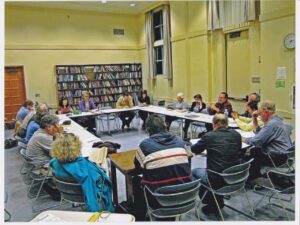[imagesource: Getty Images]
Damien Hirst is not short of cash.
According to Celebrity Net Worth, the English artist has amassed a fortune of roughly $700 million, making him one of the most commercially successful artists of all time.
The 57-year-old made history in 2008 when he skipped the usual gallery system and went straight to Sotheby’s to auction off his artwork. The auction raised $198 million and broke the record for a one-artist auction.
Hirst is in the news this week after he began burning hundreds of his own artworks after selling a series of non-fungible tokens (NFTs), reports the BBC:
The artist told buyers who bought pieces from his latest collection to choose either the physical artwork or the NFT representing it. Those who chose the NFTs were told their corresponding physical piece would be destroyed.
Asked how he felt to be burning the works, Hirst [below] said: “It feels good, better than I expected.”

…It has been estimated the works being burned are collectively worth almost £10 million.
Hirst created 10 000 unique dot paintings in 2016, each with its own title.
The sold-out NFT collection is called The Currency and is made up of 10 000 NFTs which correspond to 10 000 original pieces of art.
5 149 buyers chose the original artworks and 4 851 chose the NFTs.
Burn, Damien, burn:
Could he not have sold the unwanted physical artworks for charity rather than burning them? Those who chose to go with the NFT option could choose to give their permission for that to happen and you raise millions.
Perhaps that would undercut the entire concept.
Seth has a few thoughts on the matter, which I’ll share with you:
There doesn’t seem to be agreement on what role NFTs play when it comes to physical objects. If I have an NFT for a physical object, I would see it as a placeholder for the real thing – which is surely stored somewhere else.
But the lines become blurred when an artist interprets things differently. If you have an NFT for a Banksy, is it a Banksy? You could then only sell that NFT on to somene who agrees with that concept.
As you see by the numbers, just under half his customers chose to keep the original.
When asked yesterday shortly before the burning of the first 1 000 NFTs started, Hirst said, “Who’s to judge what’s right and wrong and what’s real and not?”
It’s believed the NFTs sold for $2 000 each.
Over the next two weeks, the burning will continue at Hirst’s Newport Street Gallery near Vauxhall, south London.
Speaking to Sky News, he said he viewed the process as transformative, rather than destructive:
“I’m kind of rooted in the physical world, so I find the digital world more challenging,” he said. “I think this has to be part of the process. To create truly digital artworks is to destroy the physical artwork.”

…Hirst says he views The Currency as a work of art in which people participate by buying, holding, selling and exchanging the works. The community, the burning, is all part of the art, part of the experiment.
10 000 NFTs at $2 000 a pop is a cool $20 million, in case you weren’t keeping count.
From the outside, it might sound like a giant waste of money. However, the person who bought NFT number 2 604 has since flogged it for $172 239.
According to Hirst, the NFTs are trading on average for around $7 000 at present, which is an impressive return on investment.
We live in strange times.





